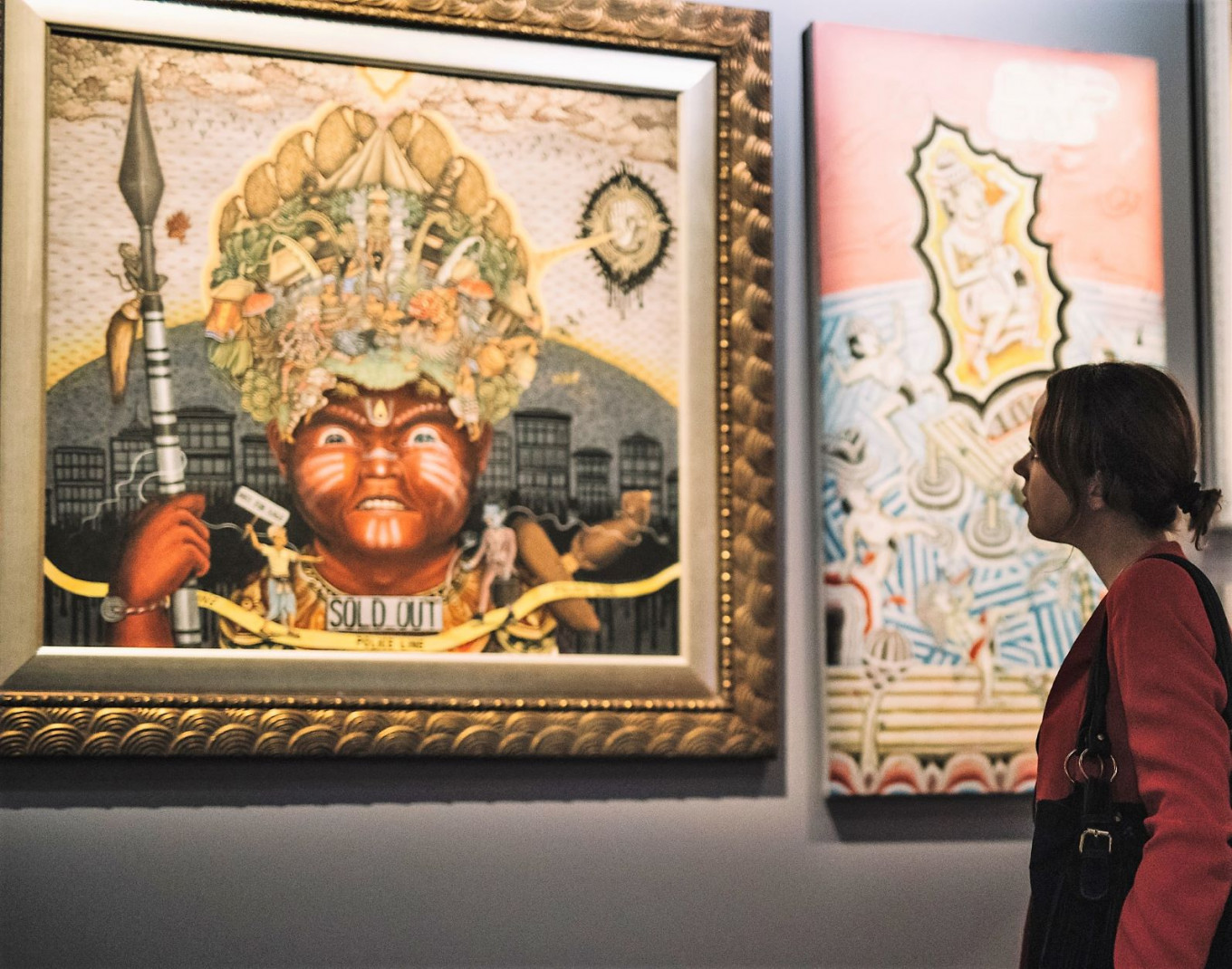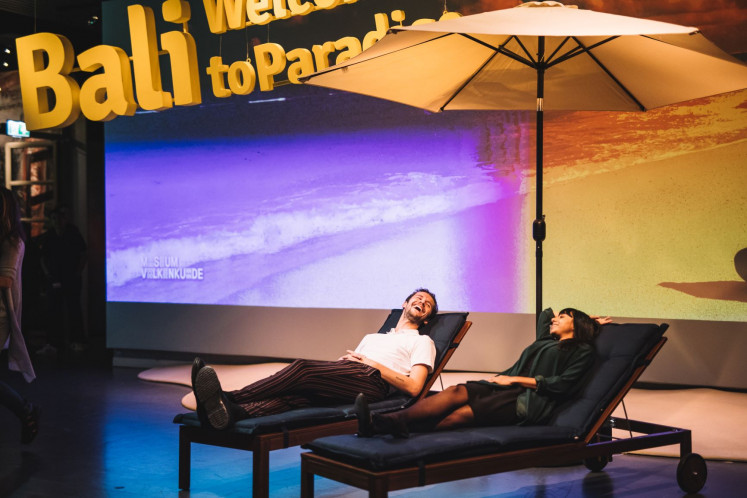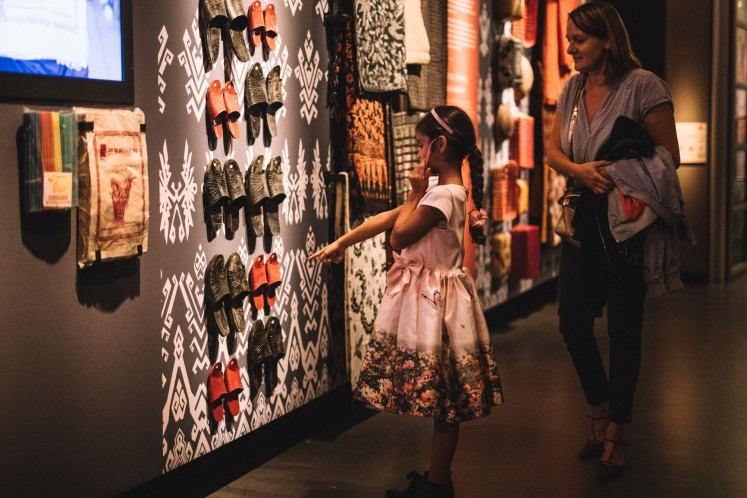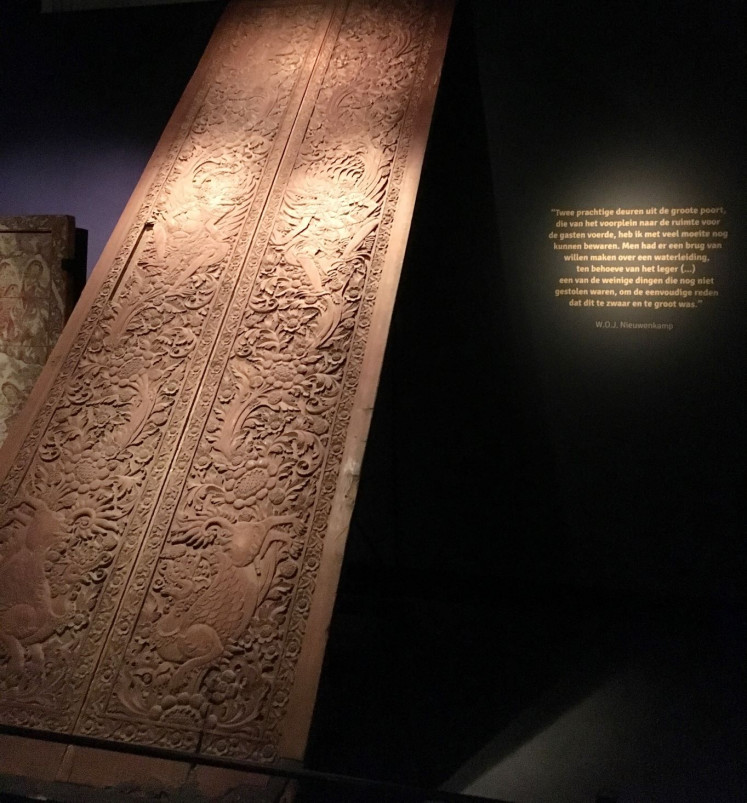Popular Reads
Top Results
Can't find what you're looking for?
View all search resultsPopular Reads
Top Results
Can't find what you're looking for?
View all search results‘Welcome to Paradise’: Dutch exhibit reimagines contemporary Bali
The Volkenkunde Museum in Leiden, the Netherlands, is holding a comprehensive exhibit on Bali that explores its history, culture and contemporary issues to go beyond its image as a "paradise island".
Change text size
Gift Premium Articles
to Anyone
A
Dutch museum is holding its first major exhibition on one of the world’s most famous islands until May 26, covering Bali’s unique form of Hinduism, its bloody colonial past and current environmental threats.
“Our idea is that you come to the exhibition with the knowledge of a tourist and leave as a seasoned traveler,” the Volkenkunde Museum's Southeast Asia curator, Francine Brinkgreve, said during the opening of the “Bali – Welcome to Paradise” exhibition in Leiden.
The Volkenkunde Museum, also called the National Museum of Ethnology, is one of the world’s oldest ethnology museums.
Although it is located half a world away from the small island to the east of Java, the Netherlands has centuries of historical ties with Bali through its colonial rule of the Indonesian archipelago.
Brinkgreve said the exhibition aims to raise visitors’ awareness of “the other side of commercialization and tourist paradises [...] by using current, personal stories, historical and contemporary objects, religious and everyday art, photographs and films”.
The entrance hall to the exhibition has giant screens depicting “paradise” as waves rolling onto a white sandy beach, tourists at temples and Balinese in colorful traditional dress. Two beach chairs with a parasol are arranged invitingly in the middle of the hall.
The exhibit then opens up into five thematic rooms: the first room provides tourism statistics and how these relate to the island’s agriculture. A hallway filled with textiles, knick-knacks and other typical souvenirs leads to rooms showcasing Dutch colonial history in Bali and Hinduism and art. The exhibition ends in a spacious area featuring the island’s main rituals, complete with a life-sized surround display.
“The rooms are situated in such a way that visitors start with the more obvious images of Bali and slowly get a deeper understanding of the island and its people,” said the exhibition's organizer, Anna Tiedink.
One subject the exhibition clearly intended to underline is Bali’s swelling environmental problem: immediately behind the large screen displaying the "paradise" beach is an image of the Kuta oceanfront, literally buried in plastic waste. Just across this is an equally large screen showing the typical congestion of Bali’s overcrowded towns.
Aside from the mountain of waste left by millions of tourists, artist and environmental activist Made Bayak makes an insightful cultural observation about local contributions to the waste problem. “In the past, we used to eat from leaves and discard them, which was OK, as they are biodegradable. But with plastic it’s very different, and our people are still not fully aware of this,” he says in a video.
Made also speaks about Bali’s water problem created by the ever-growing tourism industry. “A five-star hotel uses more water in a day than a whole village does.” This puts the island’s agriculture, which was previously key to Bali’s existence, under intense pressure, particularly as acres of arable land continues to be sold to property developers and turned into resorts or villas.
The looming environmental disaster does have a silver lining, the exhibition notes: below the image of Kuta's plastic horror is a video from the Soul Surf Project, one of the numerous environmental organizations that are active in Bali.
The Soul Surf Project focuses on raising environmental awareness among children and encourages them to participate in tackling the problem. “During our visits to Bali, we became increasingly aware of local initiatives trying to fix the plastic problem,” Brinkgreve noted.
She points out that "Welcome to Paradise" is the first exhibition on Bali that places the environmental issue in context: “Past Bali exhibitions focused mostly on art, culture, religion and rituals.”
A video featuring I Dewa Ayu Evayanti, a 26-year-old who works at a villa, sums up how much tourism is part of life for many Balinese: “I have been selling postcards to tourists since I was in the third grade,” she says.
When Mount Agung rumbled and erupted in 2017, Ayu Evayanti says that the villa remained vacant for at least a month. “Without tourists, we’d be unemployed,” she underlines.
About 40 percent of the 14.4 million international tourists Indonesia received in 2017 traveled to Bali, which comprises of only 0.2 percent of the country’s total land mass.
In the same year, the island also welcomed 8.7 million domestic tourists. Compare that to the hundred or so foreign tourists who visited Bali in 1900, around the time the Netherlands tightened its grip on the island.
The Dutch colonized the island relatively late: it was only around the early 20th century that the Balinese kingdoms were overpowered. This period was also marked by the infamous puputan ritual, in which kings, royal families and hundreds of subjects committed mass suicide rather than surrender to their enemy.
On one wall of the exhibition is a quote from painter W.O.J. Nieuwenkamp, who happened to be in Bali in 1906 to gather artefacts for the Volkenkunde Museum. His witness account of a puputan in Badung reads: “Our soldiers stood with cannons at the entrance (of the palace). Every time, some hundred Balinese – men, women and children – went past the gates. The men stabbed the women and children to death, and ran onto the troops and offered themselves to be shot […] The king himself came out carried on a sedan chair, dressed in full ornate and ended his life like the others.”
Silent witness: These intricately carved wooden double doors from Badung Palace were witnesses to the tragedy that occurred in the early 20th century, when the Dutch overpowered the sultanate. At 4 meters tall, the doors are displayed at an angle to fit into the exhibition room. (Linawati Sidarto/-)The exhibition's most impressive object is a silent witness to that tragedy: a four-meter-tall, intricately carved wooden double door from the Badung Palace.
“They (Dutch soldiers) wanted to use the doors as a bridge above some water pipes for the use of the army … they were one of the few things not yet stolen, for the simple reason that they were too heavy and too big,” Nieuwenkamp observed.
The exhibit explains that “in order to make the Netherlands and the rest of the world forget the violence, the colonial government created the image of Bali as a paradise island. Before long, the tourism industry took off”.
The local arts community received an international boost from a group of European painters who worked and settled on Bali, like Walter Spies, whose work is part of the exhibition.
In an essay on the exhibit published in the Trouw daily, philosophy professor Jos de Mul noted: “Spies insisted that Balinese painters adjusted the format of their paintings to the size of tourists’ suitcases."
The works of young artists are on display beside the more traditional Balinese paintings in the exhibit's Art Gallery, like I Wayan Aris Sarmanta’s Bali Not for Sale (Tangis Amarah Pulau Kecil), which depicts an angry, red-faced child with a crown in the shape of the island and the words “Sold Out” on his chest.
Tiedink, who had never been to Bali prior to her research trip last year for the exhibition, said what surprised her most was “how actively involved the young generation is in their religious and cultural customs”, as seen in the videos on Bali’s life cycle rituals of marriage, teeth filing, birth ceremonies and cremation.
Glaringly absent for an exhibition that tries to show the darker side of Bali, however, is mention of contemporary violence on the island: the mass killings following the failed 1965 coup blamed on Indonesian communists, and the terrorist attacks of 2002 and 2005 that killed hundreds of Balinese and foreign tourists.
“There was limited space, and we had to make choices,” Brinkgreve said in response to the omission.
Rob Badoux, a museum visitor, mostly saw the sunny side of the island. “It’s beautifully displayed: the rituals, the colors. This has really inspired us to go and visit Bali,” he said.
Hansje Heller, who visited Bali last year, said she particularly liked “the combination of art and history” in the exhibition. (ste)














